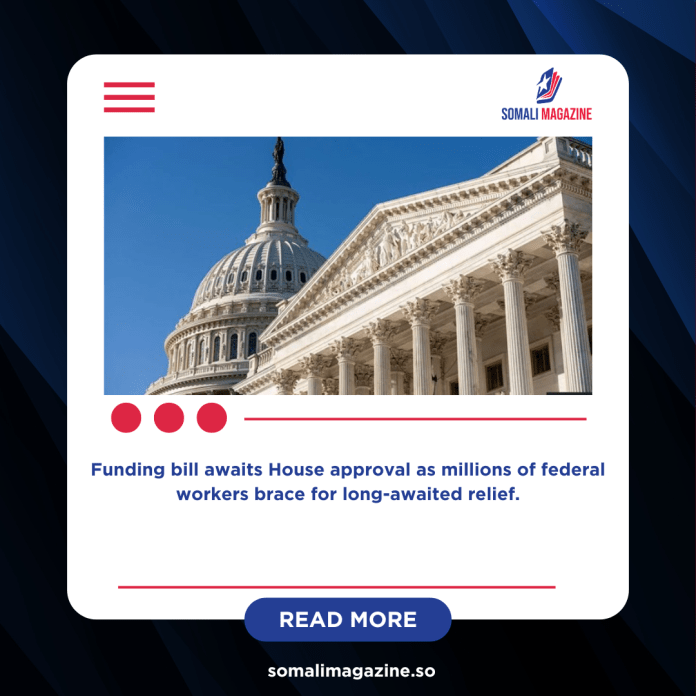Facebook Twitter (X) Instagram Somali Magazine - People's Magazine
A deal to reopen the US government has passed the Senate, signaling that the country’s record-long shutdown could soon come to an end. The funding measure, approved by a 60-40 vote on November 10, now heads to the House of Representatives for final approval before it can be signed into law by President Donald Trump. The shutdown will only officially end once that happens, meaning many federal services will remain suspended and about 1.4 million government workers will stay on unpaid leave or continue working without pay for a few more days.
The Senate vote succeeded after seven Democrats and one independent joined Republicans to pass the bill. The agreement will fund the federal government until January 30 and ensure that all federal workers receive back pay for the time they missed. It also reverses the layoffs caused by the shutdown and provides funding for food assistance under the Supplemental Nutrition Assistance Program (SNAP) through September 2026. President Trump said he would accept the deal, while Democrats secured a future vote in December on extending key healthcare subsidies set to expire later this year—a major point of contention throughout the negotiations.
The bill now faces a tough test in the Republican-controlled House, where the party has only a narrow two-seat majority. Most Republicans are expected to support it, but nearly all Democrats will likely vote against it. House Speaker Mike Johnson has not guaranteed support for the healthcare subsidy provision, adding uncertainty to the outcome.
The shutdown began on October 1 after lawmakers failed to agree on a budget. Both chambers of Congress must approve a spending plan for it to become law, but Republicans fell short of the 60 votes needed in the Senate to pass an earlier proposal. Democrats used their leverage to demand an extension of tax credits that make health insurance more affordable for millions of Americans. Although the House passed a temporary funding bill, the Senate’s rejection led to the shutdown—the first in nearly seven years.
During the shutdown, thousands of government employees deemed “non-essential” were furloughed without pay, while essential services like law enforcement, Social Security, Medicare, and mail delivery continued. Military personnel continued to receive pay, but air traffic controllers worked without pay, causing flight delays and cancellations as many called in sick. More than 42 million Americans who rely on SNAP food aid received reduced payments after the Supreme Court allowed the administration to temporarily withhold some funds. Meanwhile, members of Congress continued receiving their salaries, adding to public frustration.
Economically, shutdowns generally cause short-term damage similar to natural disasters. While their overall effect on the economy is limited, they still disrupt many areas of daily life. Government contractors—especially small businesses—often suffer the most since they are not guaranteed back pay once the shutdown ends. Analysts estimate that this shutdown has cost the economy around $15 billion a week, reducing economic growth by 0.1 to 0.2 percentage points weekly.
Government shutdowns are not new in the United States. The previous record for the longest shutdown lasted 35 days in 2018 during Trump’s first term. There were also several under past presidents, including eight during Ronald Reagan’s time in office, a 21-day shutdown under Bill Clinton in 1995, and a 16-day one during Barack Obama’s presidency in 2013. Each reflects the deep political divisions that make it difficult for Congress to reach consensus on the federal budget.
If the House quickly approves the Senate’s deal and President Trump signs it into law, government operations could resume within days, offering relief to millions of workers and families affected by the standoff. However, since the agreement only funds the government until January 30, another potential shutdown could loom early next year if lawmakers fail to reach a longer-term budget deal.

